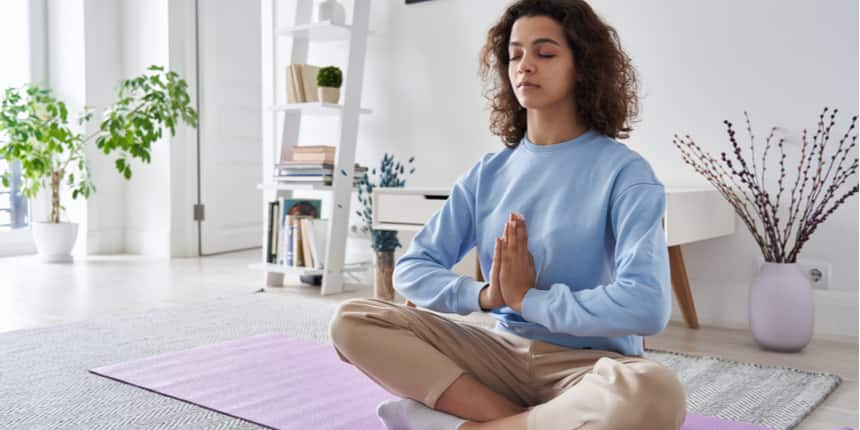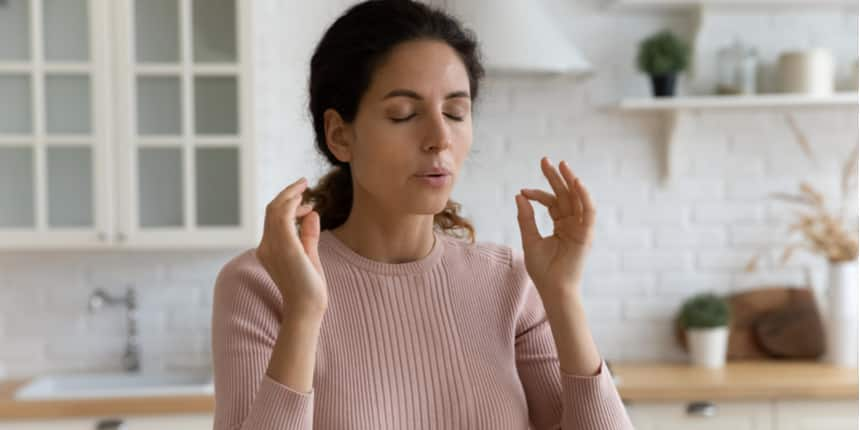Stay Grounded, Prevent Stress: Follow These 7 Mindfulness Tips
Have you often found yourself working so much that you forgot to drink water? Or binged watch to an extent that you forgot about lunch? Do you happen to scroll through social media and realise hours have gone by? When was the last time you went for a walk without your phone, worked out without having the music plugged into your ears, or simply had a meal just by yourself, without any distractions?

In this fast-paced world, everyone seems to be in a hustle, be it your personal or professional life. Multitasking has become a norm, hyper-productivity is glorified, and slowing down is deemed as a weakness, or sometimes, even failure. This is more common now, given that the past two years have been about working and studying from home. This is enough indication that we all need to be more present, more mindful.
The Cambridge dictionary defined ‘Mindfulness’ as “the practice of being aware of your body, mind, and feelings in the present moment, to create a feeling of calm.” In other words, ‘mindfulness’ means being present in the moment, able to closely observe your body and your surroundings. The term is often wrongly confused with ‘meditation’. While the former is a broader concept, meditation is one of the means to attain mindfulness.
Also Read | What Is Academic Burnout? Here Are Ways You Can Deal With It
The Importance Of Mindfulness
Before we talk about the ways to practice mindfulness, let us understand why we need to train ourselves on mindfulness, and what are its benefits.
Lots To Do Amid Multiple Changes
For students, life is usually full of hustle and bustle. You are expected to get good grades, finish those assignments, participate in extracurricular activities, go for that additional coaching, do internships, build social relationships, and what not! It is essential to note that it is during this phase that students are more vulnerable to issues like stress and anxiety, given that they undergo multiple physiological and psychological changes.
Challenges Of The Pandemic
For this generation, the pandemic brought its own set of challenges, navigating everything through an electronic device, blurring the boundaries between home and classroom leading to a multifold increase in attention and concentration difficulties, screen time, and thus, losing out on a crucial aspect of social development, that is, going to school.
Mindfulness Enhances Well-Being
Practising mindfulness has been shown to improve concentration, reduce stress and anxiety, and bring about betterment in the academic performance of students. Thoroughly carried out interventions based on mindfulness have shown the potential of tapping into the concerns of the young people and improving their well-being, reducing worries, anxiety, distress, reactivity and unhealthy behaviour, improving sleep, self-esteem, and bringing about more calmness, relaxation, and self-regulation and awareness. Teenagers who are mindful, either through temperament or training, tend to experience greater well-being; and mindfulness correlates positively with positive emotion, popularity and friendship, and negatively with negative emotion and anxiety (Miners, 2008).
Thich Nhat Hanh, who is known as the Father of Mindfulness, stated in his book, “The Art Of Power” - “The energy of mindfulness helps us be aware of what is going on. When you breathe in and you know that you are breathing in, this is mindfulness of breathing. When you drink your coffee or tea, and you know that you are drinking coffee or tea, this is mindfulness of drinking. When you walk and you know you are walking, and you enjoy every step you take, this is mindfulness of walking. So, these kinds of practices generate the energy of mindfulness, helping you be fully alive, fully present to touch the wonders of life for your nourishment and healing.”
Also Read | Why And How To Not Make Exams Larger-Than-Life Events
Mindfulness Techniques For Practice
We shall now discuss a few simple ways to practice mindfulness in our everyday lives.
Breathing Techniques
One of the simplest ways to centre yourself is to focus on your breathing. It is most likely that if at any given moment when we are stressed, and we bring attention to our breathing, it would be shallow or rapid. When we intentionally focus on our breathing and take deep breaths, it helps us to gather our thoughts, and our presence, and bring about a feeling of equilibrium.
One of the examples of breathing techniques is 4-7-8. Find a quiet place to practice. You inhale with your nose and count 4 seconds, hold for 7, exhale from your mouth, and hold for 8 seconds. Repeat this at least 10-15 times. Put one palm on your chest, another on your belly and notice how the heart beats, how the belly rises and contracts. While doing this, additionally you should visualise a calm, soothing scenery, for example, a sunset, or a river flowing through the lush green mountains.
 Breathe In, Hold, Breathe Out
Breathe In, Hold, Breathe Out
Grounding
In the moments when we feel anxious, our minds usually wander off to either the past or the future, losing touch with the here and now, and getting into a thought spiral. Grounding techniques help you to bring yourself back into the present. The 5-4-3-2-1 method is proven to be highly effective.
Notice any 5 objects that you see around you, any 4 things that you can touch or feel, 3 things that you can hear, 2 things that you can smell, and any 1 thing that you can taste. As soon as we try to engage consciously in this activity, our brain starts to focus on the present, and we feel more oriented and calm.
Body Scan
If you have seen a document being scanned, you would have noticed how a sharp, laser-like beam of light passes to and fro, taking in each and every detail of the document and showing the exact same thing on the screen! In a body scan, you apply the same concept to your body. Here, instead of the words, you scan the stress and tension stuck in the parts of your body. The key mechanism is to lie down, and start from one end of the body by bringing your attention to that body part, contracting and releasing the muscles at intervals of 5-10 seconds each, while taking in deep breaths and keeping your eyes closed. Say, starting from your forehead, eyes, face, neck, shoulders, going till your toes, one by one. When you contract, you inhale, and when you release, you exhale, and imagine all the stress being blown out of your body. Doing this for 10-15 minutes daily helps us to connect with our bodies and release any muscle tension, and feel more in touch with our bodily sensations.
Pause And Reflect
While we’re emphasising bodily experiences, it is helpful to check in with ourselves, i.e., with our thoughts, actions, and feelings. Sit with yourself for a few minutes and take a note– ‘What am I thinking right now?’; ‘What are my thoughts indicating?’; ‘What am I feeling and why am I feeling this way?’; ‘How does it impact my actions?’ It is essential to be non-judgmental and compassionate towards yourself while you do this activity. By doing this, you can become more aware and mindful of your thoughts and emotions, which in turn aids in better management of them.
Find Your ‘Me-Time’ In A Day
As a student, it is so easy to lose oneself in multiple engagements, and hustle back and forth between tasks. This may not only overwhelm you after a point but may also drive your system into exhaustion. Engage in at least one activity in the day without any distractions, for example, leave Netflix and have a meal just by yourself, feel the texture of the food and smell it as you grab a bite, or do that workout without noisy music, and feel those endorphins getting released in your body.
Go On A Social Media Detox
Needless to say, we often go on a detox from things that we have been engaging in excessively, and whose unhealthy impact we can see on ourselves. No doubt, social media can be alluring and hard to resist. No wonder one may end up ‘doom scrolling’ because there is so much content to consume, with no end to it. Reflect on the content you’re seeing and ask yourself, ‘Is it helping me?’; ‘Am I learning anything from it?’; ‘Is it bringing me joy or triggering any negative thoughts and feelings?’ Keep a few hours for no consumption of your smartphone. Your eyes will bless you and so will your mind. You’ll be surprised to see how much time you would have by yourself to just be or do something productive.
Also Read | Build Your Brain: Ways To Improve Long-Term Memory
Connect With Nature
Last but not the least, spend some time in nature. Bring out your inner child, ride that swing in the park, or walk barefoot on the grass, or while sipping your favourite beverage in the evenings, glance at the sky as the clouds pass by, or see those birds as they make different formations and head back to their homes. Water those houseplants you have, and notice those tiny, shiny green leaves unfold. Human beings belong to nature and the closer one can connect with it, the more mindful one would feel.
It is important to note that these techniques require practice and patience. They may not show immediate results and you may initially find your mind wandering, which is quite normal. Give yourself time. Also, not every technique will be helpful for you. So explore and see what works for you.
References-Miners, R. (2008) Collected and Connected: Mindfulness and the early Adolescent. Dissertations Abstracts International: Section B. The Sciences and Engineering, 68,9.
Sanskriti Khera is a Counselling Psychologist, with five years of extensive hands-on experience in helping young adults navigate through social and emotional concerns. Her approach to counselling is person-centered, trauma-informed, and insight-oriented. She was formerly Counsellor at the Ashoka Centre For Well-Being, Ashoka University, Sonepat. Currently, she is Consultant with Daffodils Therapy Studio, New Delhi.
